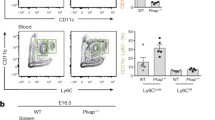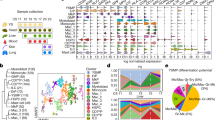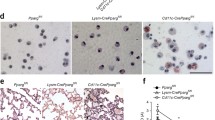Abstract
Endothelial monocyte-activating polypeptide II (EMAP II) is a chemoattractant for monocytes and granulocytes. EMAP II is translated as a precursor protein, proEMAP II, and is proteolytically cleaved to become the mature, biologically active cytokine. In this study we show that the EMAP II mRNA and the EMAP II precursor protein are constitutively expressed by all cell types analyzed in vitro, whereas the mature cytokine is only present in the supernatant of apoptotic cells. During mouse embryogenesis we found widespread expression of the EMAP II mRNA with transcripts being abundant in areas of tissue remodeling, where a large number of apoptotic cells could be detected by TUNEL staining. In the adult mouse, strong expression of the EMAP II mRNA is restricted to the brain, testis and thymus. Interestingly, prominent signals for EMAP II mRNA are found in local correlation with sites of apoptosis in thymus and testis but not in the brain. We propose that during development, the generation and release of the mature EMAP II may provide a mechanism for the recruitment of phagocytic cells to sites of programmed cell death. In the adult brain, the generation of mature EMAP II may contribute to the recruitment of monocytes and the immunosurveillance of this tissue.
Similar content being viewed by others
References
Kao J, Ryan J, Brett G, et al. Endothelial monocyte-activating polypeptide II. A novel tumor-derived polypeptide that activates host-response mechanisms. J Biol Chem 1992; 267: 20239–20247.
Kao J, Houck K, Fan Y, et al. Characterization of a novel tumorderived cytokine: Endothelial-Monocyte Activating Polypeptide II. J Biol Chem 1994; 269: 25106–25119.
Quevillon S, Agou F, Robinson JC, Mirande M. The p43 component of the mammalian multi-synthetase complex is likely to be the precursor of the endothelial monocyte-activating polypeptide II cytokine. J Biol Chem 1997; 272: 32573–32579.
Park SG, Jung KH, Lee JS, et al. Precursor of pro-apoptotic cytokine modulates aminoacylation activity of tRNA synthetase. J Biol Chem 1999; 274: 16673–16676.
Knies UE, Behrensdorf HA, Mitchell C, et al. Regulation of endothelial monocyte-activating polypeptide II-release by apoptosis. Proc Natl Acad Sci USA 1998; 95: 12322–12327.
Schwartz SM. Selection and characterization of bovine aortic endothelial cells. In Vitro 1978; 14: 966–980.
Clauss M, Weich HA, Breier G, et al. The vascular endothelial growth factor receptor flt-1 mediates biological activities: Implications for a functional role of placenta growth factor in monocyte activation and chemotaxis. J Biol Chem 1996; 271: 17629–17634.
Hartmann KKP, Papa V, Brown EJ, Doerries U, Rosenthal SM, Goldfine ID. A rapid and one step method for isolation of poly(A)+ RNA from cells in monolayer. Endocrinol 1990; 127: 2038–2040.
Breier G, Albrecht U, Sterrer S, RisauW. Expression of vascular endothelial growth-factor during embryonic angiogenesis and endothelial-cell differentiation. Development 1992; 114: 521–532.
Gavrieli Y, Sherman Y, Ben-Sasson S. Identification of programmed cell death in situ via specific labeling of nuclear DNA fragmentation. J Cell Biol 1992; 119: 493–501.
R¨osl F. A simple and rapid method for detection of apoptosis in human cells. Nucl Acid Res 1992; 20: 5243–5247.
Ge SJ, Yao XL, Yang ZX, Zhu ZP. An Arabidopsis embryonic lethal mutant with reduced expression of alanyl-tRNA synthetase gene. Cell Res 1998; 8: 119–134.
Cerini C, Semeriva M, Gratecos D. Evolution of the aminoacyltRNA synthetase family and the organization of the Drosophila glutamyl-prolyl-tRNA synthetase gene. Intron/exon structure of the gene, control of expression of the two mRNAs, selective advantage of the multienzyme complex. Eur J Biochem 1997; 244: 176–185.
Zhang JZ, Somerville CR. Suspensor-derived polyembryony caused by altered expression of valyl-tRNA synthetase in the twn2 mutant of Arabidopsis. Proc Natl Acad Sci USA 1997; 94: 7349–7355.
Schwarz M, Lee M, Zhang FR, et al. EMAP II: A modulator of neovascularization in the developing lung. Am J Physiol 1999; 20: L365–L375.
Schwarz MA, Kandel J, Brett J, et al. Endothelial-monocyte activating polypeptide II, a novel antitumor cytokine that suppresses primary and metastatic tumor growth and induces apoptosis in growing endothelial cells. J Exp Med 1999; 190: 341–353.
Blaschke AJ, Staley K, Chun J. Widespread programmed cell death in proliferative and postmitotic regions of the fetal cerebral cortex. Development 1996; 122: 1165–1174.
Schluesener HJ, Seid K, Zhao Y, Meyermann R. Localization of endothelial-monocyte-activating polypeptide II (EMAP II), a novel proinflammatory cytokine, to lesions of experimental autoimmune encephalomyelitis, neuritis and uveitis: Expression by monocytes and activated microglial cells. Glia 1997; 20: 365–372.
Plate KH, Breier G, Weich HA, RisauW. Vascular endothelial growth-factor is a potential tumor angiogenesis factor in human gliomas in vivo. Nature 1992; 359: 845–848.
Perry VH, Crocker PR, Gordon S. The blood-brain-barrier regulates the expression of a macrophage sialic acid-binding receptor on microglia. J Cell Sci 1992; 101: 201–207.
Ashwell K. Microglia and cell death in the developing mouse cerebellum. Brain Research Develop Brain Res 1990; 55: 219–230.
Moujahid A, Navascues J, Marinteva JL, Cuadros MA. Macrophages during avian optic nerve development-relationship to cell death and differentiation into microglia. Anat & Embryol 1996; 193: 131–144.
Gehrmann J, Matsumoto Y, Kreutzberg GW. Microglia-intrinsic immune effector cell of the brain [Review]. Brain Res Rev 20: 269–287.
Author information
Authors and Affiliations
Rights and permissions
About this article
Cite this article
Knies, U.E., Kröger, S. & Clauss, M. Expression of EMAP II in the developing and adult mouse. Apoptosis 5, 141–151 (2000). https://doi.org/10.1023/A:1009632712876
Issue Date:
DOI: https://doi.org/10.1023/A:1009632712876




